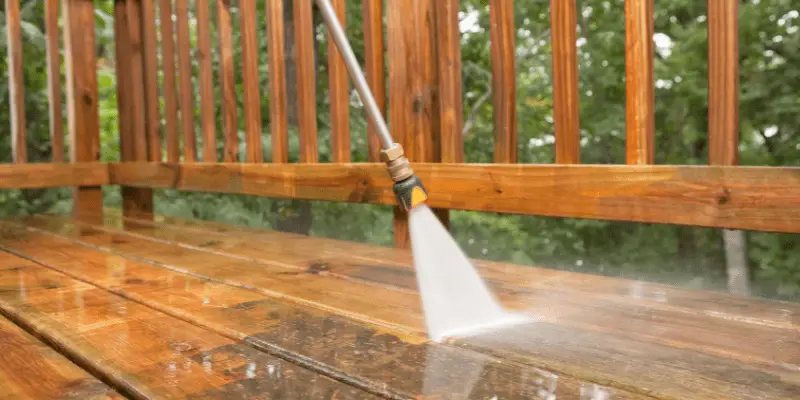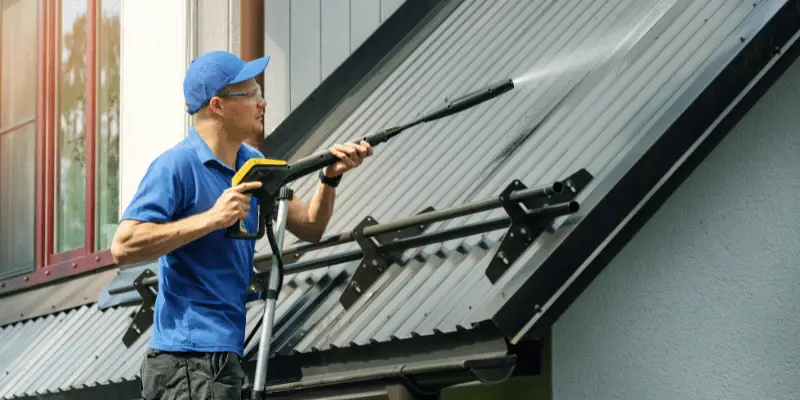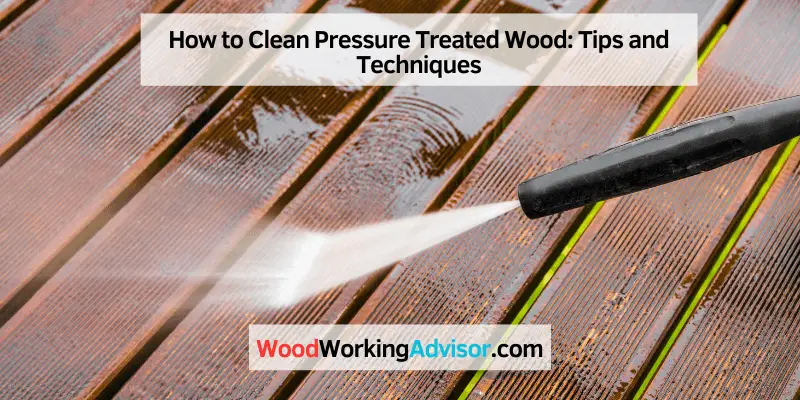To clean pressure treated wood, use a diluted solution of soap and water with a stiff brush to remove mildew and dirt. Avoid using bleach, which can damage the cellular structure of the wood.
As an alternative, stain the wood using a paint pad applicator for accuracy and efficiency. Maintaining a pressure treated wood deck or structure can be a challenge due to its susceptibility to weather and other outdoor elements. Regular cleaning helps to remove any dirt, grime or mildew that may have accumulated on the wood surface.
However, improper cleaning techniques like using bleach or a pressure washer can cause damage to the wood and reduce its lifespan. We will explore the best practices for cleaning pressure treated wood and keeping it looking new for years to come.
Cleaning Techniques For Pressure Treated Wood
Cleaning pressure treated wood requires taking necessary precautions to avoid damaging the wood. The use of a diluted solution of soap and water with a stiff brush can remove mildew and dirt. Using bleach and pressure washing is not recommended.
Using a paint pad applicator to stain the wood is recommended for new-looking wood.
Pressure treated wood is durable, long-lasting, and resistant to rot and insect damage. However, after a few years, it can begin to look dull and dirty due to exposure to the elements. Fortunately, there are several techniques you can use to clean your pressure treated wood and restore its natural beauty. Here are some effective cleaning techniques you can use:
Using a Power Washer
Using a power washer is an effective way to clean pressure treated wood quickly and efficiently. A power washer uses high pressure to blast away dirt and grime from the surface of the wood. To use a power washer on your pressure treated wood, follow these steps:
1. Start by sweeping the deck to remove loose debris such as leaves and twigs.
2. Attach a low-pressure nozzle to your power washer and set the pressure to around 1500 PSI.
3. Begin spraying the wood, working in sections from one end of the deck to the other.
4. Be sure to keep the nozzle moving constantly and maintain a distance of at least 6 inches from the wood.
5. Once you’ve washed the entire deck, rinse it thoroughly with water.
Using Soap and Water
If you prefer a more gentle approach, you can clean your pressure treated wood with soap and water. Here’s how:
1. Mix a solution of mild dish soap and water in a bucket.
2. Dip a stiff-bristled brush into the solution and scrub the wood in a circular motion, paying special attention to any areas with mold or mildew.
3. Rinse the deck thoroughly with a hose or pressure washer.
4. Allow the deck to air dry completely before using it.
Misting the Deck
Misting your pressure treated wood can help keep it clean between deeper cleanings. Misting is also a good technique to use if you have sensitive plants or flowers near your deck that may be damaged by soap or chemicals. Here’s how:
1. Fill a garden sprayer or spray bottle with plain water.
2. Spray the water evenly over the deck, making sure to mist the entire surface.
3. Repeat as needed, depending on the weather and amount of foot traffic on the deck.
Cleaning Tips
Here are a few tips to keep in mind when cleaning pressure treated wood:
– Always wear protective clothing such as gloves, eye protection, and a respirator mask when using a power washer or chemicals.
– Test any cleaning solution on a small, inconspicuous area before cleaning the entire deck to ensure it doesn’t damage or discolor the wood.
– Never use bleach or chlorine-based cleaners on pressure treated wood, as these can damage the wood fibers and cause discoloration.
– Use a soft-bristled brush to clean the wood, as hard-bristled brushes can scratch the surface and damage the wood.
– Regularly remove leaves, twigs, and other debris from your deck to prevent mold and mildew growth.

What Not To Do With Pressure Treated Wood
When cleaning pressure treated wood, it’s important to avoid using bleach as it can damage the cellular structure. Instead, use a diluted solution of soap and water with a stiff brush to remove mildew and dirt. Refrain from using treated wood where it will come into contact with drinking water supplies or human and animal food, and avoid pressure washing as it can be harmful to the wood.
When it comes to pressure treated wood, there are certain things you should avoid doing in order to keep it in good condition and make it last for years to come. In this section, we will cover the Federal Guidelines for Using Treated Lumber and why you should avoid using bleach on Pressure Treated Wood. Following these guidelines will not only keep your wood looking great but will also help it maintain its structural integrity over time.
Federal Guidelines For Using Treated Lumber
There are guidelines set by the federal government that you should follow when purchasing and using Pressure Treated Wood. Refrain from using any type of treated wood where the wood will come into direct or indirect contact with drinking water supplies.
You should also avoid using treated wood where the wood will come into contact with human or animal food or with beehives. These guidelines are put in place to protect both humans and the environment from potentially harmful chemicals that may be present in the treated lumber.
Avoid Using Bleach On Pressure Treated Wood
You may think that bleach is a great way to clean and brighten Pressure Treated Wood, but this is not the case. Bleach is a basic solution, and the natural pH of wood is slightly acidic. As a result, using bleach on wood shifts the pH from near neutral to a basic pH that will damage the cellular structure. This can lead to discoloration, weakening, and other issues that will shorten the lifespan of your wood.
Instead of using bleach, you can use a mild solution of soap and water with a stiff brush to remove mildew and dirt. For more stubborn stains, use a pressure washer with a fan tip nozzle and keep the pressure below 1500 PSI to avoid damaging the wood fibers.
Following these guidelines will help keep your Pressure Treated Wood in great condition, allowing it to look great while maintaining its structural integrity. By avoiding bleach and adhering to federal guidelines, you will ensure that your wood lasts for years to come.
Staining Pressure Treated Wood
To clean pressure treated wood, it is important to avoid using bleach as it can damage the wood’s cellular structure. Instead, use a diluted solution of soap and water with a stiff brush to remove mildew and dirt. Staining pressure treated wood can also make it look new, and using a paint pad applicator or brush can ensure accurate application.
Remember to avoid using treated wood in areas where it may come into contact with food and water supplies.

If you’re looking to spruce up your pressure treated wood and make it look new again, staining is the way to go. Staining helps protect the wood against weather elements, UV rays, and water damage. It also brings out the natural beauty of the wood’s grain, adding a touch of aesthetic appeal to your outdoor space. But how do you go about staining pressure treated wood? Here are some tips to help you get started.
Using a Paint Pad Applicator
One of the easiest ways to apply stain to a large deck or structure is by using a paint pad applicator. This handy tool allows you to apply stain evenly and quickly, without the need for a brush or sprayer. Simply pour the stain onto a flat surface, such as a paint tray, dip the pad into the stain, and apply it evenly to the surface of the wood.
Paintbrush to Stain between Cracks and Problem Areas
While a paint pad applicator may work wonders on flat surfaces, it may not be as effective in reaching tight spots, cracks, and crevices. To ensure that those hard-to-reach areas are also coated with stain, use a paintbrush. A small paintbrush will allow you to apply stain to problem areas, ensuring that every inch of the wood is protected and sealed.
In conclusion, staining pressure treated wood is a great way to keep your outdoor space looking beautiful and protected from the elements. By using a paint pad applicator for large surfaces and a paintbrush for tighter spots, you can achieve a professional-looking finish that will impress your neighbors and guests.
Frequently Asked Questions On How To Clean Pressure Treated Wood
How Do You Make Pressure-treated Wood Look New?
To make pressure-treated wood look new, use a paint pad applicator to stain the wood. This is an easy and accurate way to apply stain, and a paintbrush can be used to reach difficult areas. Generally, only one coat of stain is needed.
Avoid using bleach or pressure washing, as they can damage the wood.
Is It Ok To Pressure Wash Treated Wood?
Yes, it’s okay to pressure wash treated wood, but you should use a lower pressure setting to avoid damaging the wood. In addition, you should use a cleaning solution specifically designed for pressure-treated wood and avoid using bleach or other harsh chemicals.
Be sure to follow all manufacturer guidelines and safety precautions when pressure washing.
What Should Never Be Done With Pressure-treated Wood?
Avoid using pressure-treated wood where it may come into direct or indirect contact with drinking water supplies, human or animal food, or beehives. Furthermore, do not use bleach to clean pressure-treated wood, as it can damage the cellular structure. Instead, use a mild soap solution with a stiff brush to remove dirt and stains.
Does Bleach Ruin Pressure-treated Wood?
Bleach should not be used on pressure-treated wood as it has a basic pH that damages the cellular structure of the wood. The best way to clean pressure-treated wood is to use a diluted solution of soap and water with a stiff brush or mild dish detergent.
Avoid using any cleaning solution that may cause damage to the wood.
Conclusion
To wrap up, cleaning pressure treated wood may seem like a daunting task at first, but by following the right techniques, it can be done easily. Whether you choose to use an oxygen bleach solution, a pressure washer or a paint pad applicator to stain the deck, always ensure you prioritize safety and avoid using bleach which can damage the cellular structure of the wood.
Taking care of your pressure treated wood through regular cleaning and maintenance will not only make it look new but also increase its lifespan.


